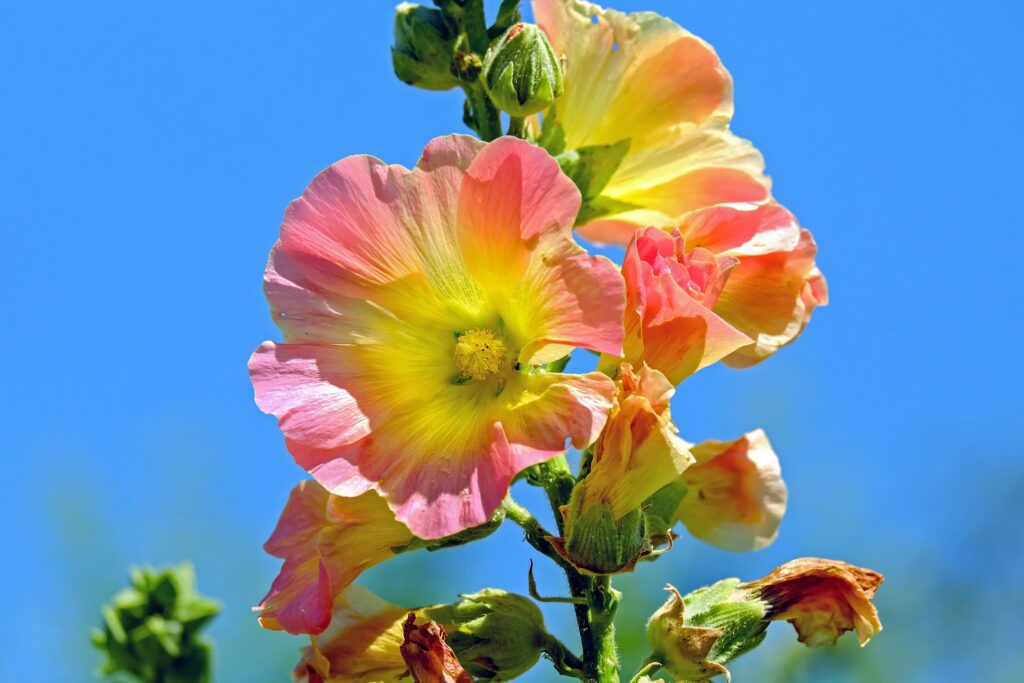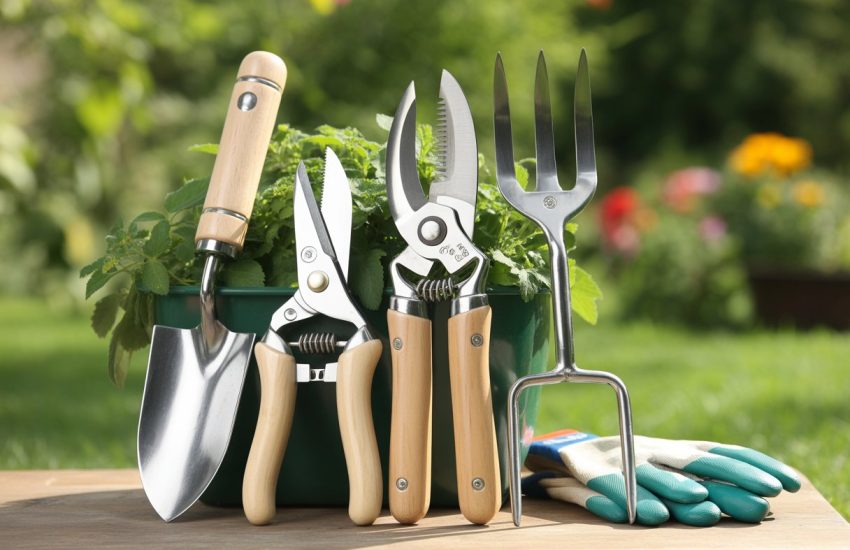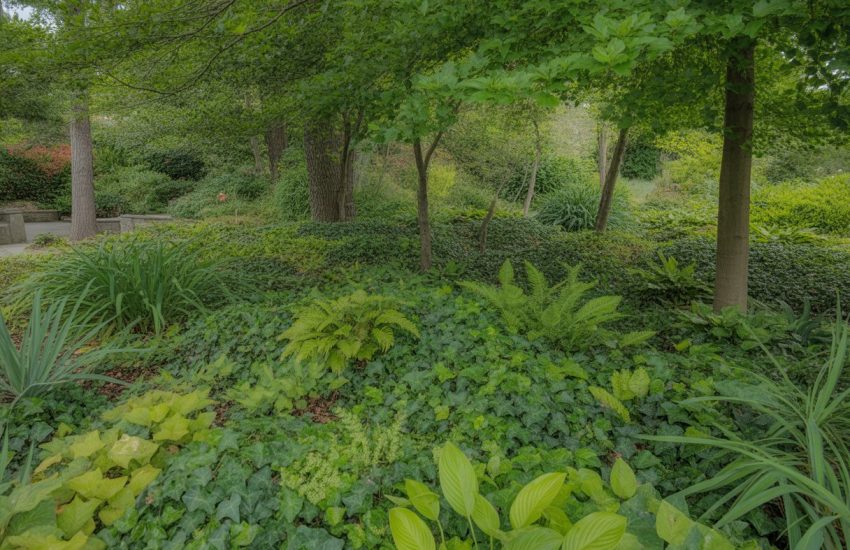Hollyhocks: How To Plant, Grow And Care
If you’re on the lookout for a flower that’s fair but not too fair, then hollyhocks may be just what you need. The tall and stately flowers are rich in history and famous for their ability to grow almost anywhere. They’re also incredibly easy to plant, care for, and grow.
With the right soil, sunlight and water, hollyhocks can thrive in your garden all summer long. Read on to learn more about these beautiful plants and how you can have a thriving hollyhock garden of your own!
Hollyhocks Characteristics
Hollyhocks are a member of the mallow family, a group of plants that are known for their wide variety and versatility. They were used in Ancient Egypt as food and medicine and were even mentioned in the Bible. The modern-day hollyhock is thought to descend from the flowers found in Chinese and Japanese art.
Hollyhocks are incredibly easy to grow and are a staple of the English British garden. They are extremely adaptable flowers that can thrive in nearly any climate and soil type. They can even handle partial shade, making them an excellent choice for areas with little direct sunlight. Hollyhocks also grow on a wide range of heights, from short-growing varieties as short as three feet to lofty varieties that top out at eight feet.

How To Plant A Hollyhock
Hollyhocks are great flowers to plant from seed. It’s easy to do and gives you a bit more flexibility than trying to find the exact hollyhock variety you want in a pot. First, you’ll want to find a good place to plant them. If you want to grow tall varieties, try to find a spot that’s at least six feet away from anything else.
Hollyhocks are known to be aggressive growers, and you don’t want to run the risk of crowding out other nearby plants. You can plant short varieties closer together, though you’ll want to leave at least two feet between each plant. You can also start hollyhocks from a rooted cutting, although starting from seed is a bit easier.
See Also: Verbena Plant Care and Grow
Care Of Hollyhocks
When caring for hollyhocks, it’s important to keep a few things in mind. First, hollyhocks are heavy feeders, so you’ll want to make sure that you’re regularly adding a high-quality fertilizer to the soil. You’ll also want to keep an eye out for pests and diseases, as hollyhocks are more prone to both than many other plants. A good rule of thumb is to inspect your plants regularly, especially if you live in an area where pests and diseases are common.
Hollyhocks also require a fair amount of water each week, so make sure that your soil stays moist but not soggy. You can also help your hollyhocks grow as tall and wide as possible by giving them adequate space. You don’t want to crowd them, as this will prevent them from growing as tall as they could. Hollyhocks also love to be planted near other tall plants, like corn. This will help keep them from outgrowing their space.
Growing Hollyhocks from Seed
Hollyhock seeds are typically sown directly into the ground when spring arrives, but you’ll want to make sure that you’ve prepared the soil first. The best soil for hollyhocks is loose, well-draining soil that’s rich in organic matter. You can amend your soil by adding compost or chicken manure to give your hollyhocks the best start. Sow your seeds about two inches apart and one inch below the soil. Keep the soil moist until your seeds have sprouted.
Once your seedlings are a few inches tall, you can thin them out. Leave the healthiest-looking seedlings in place and pull out any others, making sure you don’t damage the roots of the remaining plants while you’re at it. You want to leave at least two feet of space between each seedling, and you’ll want to keep the soil around your hollyhocks moist.
Hollyhock Problems and Their Solutions
Hollyhocks are relatively disease-free and pest-free, but you will occasionally have to deal with a few issues. Depending on the time of year, you may have to deal with a few spider mite infestations or mild fungal diseases. They are also prone to root rot, which means that you’ll have to keep an eye on the moisture around their roots.
You can also prevent root rot by making sure that your soil is well-draining. They are also susceptible to a few pests, including aphids and squash bugs. These pests are easy to spot, so you can quickly eradicate them from your garden. You can also treat mild fungal diseases with an organic fungicide spray. Root rot can be treated with the careful addition of a fungicide to the soil.
Although they are simple to grow, hollyhocks can have certain issues. You must watch out for rust when cultivating hollyhock blooms. The lower leaves are frequently attacked by rust, although it can also extend to the top leaves.
The following are some hollyhock care suggestions to help prevent rust: Do not forget to rinse from below.
- The application of a fungicide ensures that the plant has adequate airflow. Although all of these suggestions should be helpful, the rust issue is likely to persist.
- The lower branches should be kept free of rust so that it only affects the leaves and not the blossoms. This is your best option.
Conclusion
Hollyhocks are an incredibly versatile and long-lasting flower that will thrive in just about any climate. They’re also fairly easy to grow from seed and make excellent cut flowers. Hollyhocks are also edible, making them an excellent multi-purpose flower that you can use for many different things. They are a stunning addition to any garden, and they’re easy to care for and grow. They also have a long lifespan, and you’ll be able to enjoy your hollyhocks for many years to come.
FAQs
Do hollyhocks come back every year?
Most hollyhocks will come back every year, but you’ll want to make sure that you’re giving them what they need. Water your plants regularly, and make sure that you’re fertilizing them regularly. You can also add a layer of compost to the soil to give them a boost. Hollyhocks do best in soil that has a pH between 6.0 and 7.0. It’s also important to make sure that you’re harvesting your hollyhocks before they go to seed. This will prevent them from seeding in your garden and growing into a thicket of unwanted weeds. You can remove the flowers as soon as they fade or even pinch them off as they grow.
What do you do with hollyhocks when they finish flowering?
Hollyhocks are beautiful flowers that are perfect for adding a splash of color to your garden, but they can also be used in cooking. The Hollyhock flowers are edible and can be added to salads, sandwiches, and other dishes. You can also use the leaves to make tea. Once your hollyhocks have wilted and died, you can compost them or add them to your compost pile. You can also use your hollyhocks to make craft projects like flower crowns, or you can store them in jars of salt to use in your Christmas decorations. You can also press your hollyhocks between pieces of cardboard to make them last longer. This will let you save them for later, or you can give them to friends and family members as beautiful gifts.
Do hollyhocks need to be cut back for winter?
Hollyhocks are hardy flowers that can survive even the harshest of winters, but that doesn’t mean that you can forget about them in the fall. Should cut them back in the autumn to encourage new growth and prevent them from expending too much energy while they’re trying to survive the cold. You can also mulch your hollyhocks in the fall to protect them from frost and snow. You can also protect them by covering them with a blanket or sheet. Don’t put the sheet directly over them, as this will trap too much moisture and invite diseases. You can also wrap your hollyhocks in burlap or another fabric that will protect them from frost but allow them to breathe.


